Abstract
Urban upgrading programs are implemented to enhance the living conditions in a city. However, the concept of to what extent the life of the targeted communities is improved remains contested and fluid. The purpose of this study was two-fold. First, it evaluated for the first time the indoor thermal conditions in the three main urban housing types in Kigali and analyzed whether the ongoing urban renewal takes into consideration occupant thermal comfort. Second, alternatives to improve thermal performance of urban housing were investigated and recommendations were given. Results indicate that modern urban housing performed significantly greater compared to other housing types, especially during daytime. Indoor thermal conditions in the planned low-income housing were no better—and, in fact, were slightly poorer—than in the informal settlement from which households were to be relocated. Through design parameter optimization, the indoor thermal conditions in the planned low-income housing were improved by 85.5% in the daytime hours and 71.2% in the nighttime hours. These findings are valuable to officials in resettlement programs by providing insights to improve urban dwellers’ living conditions from a wholistic prospective. This can assist related parties in mitigating project failure often caused by local resistance to resettlement.
1. Introduction
Over the past decades, various nations have embarked on a journey to upgrade their urban fabric with the aim of enhancing the living conditions of their urban populations. For most of these nations, developing countries in particular, informal settlements have increasingly become a major problem for sustainable development. To tackle this issue, strict urban planning measures are put in place in the form of master plans under which land zoning and building regulations are specified.
The implementation of such master plans often requires an induced displacement and resettlement of urban dwellers, particularly low-income people who generally reside in central locations [1]. Although the main purpose of urban renewal is to improve peoples’ livelihoods, scholars have identified that, in most cities, attempts to upgrade a city’s image by clearing out informal settlements often result in living conditions that are no better—or are even worse—than those prior to urban re-development. Studies have argued that urban renewal has several socio-economic impacts on urban dwellers, such as loss of jobs, food insecurity, social disarticulation, etc. [2], describing the process as evidence of raw capitalism rather than life improvement for urban populations [3]. In terms of indoor environmental quality, a study reported that the indoor air quality in Mumbai resettlement dwellings was as bad as in the informal settlements where households were relocated from [4]. Given the primary role of a building is to adequately shield people from unfavorable outdoor conditions and to provide a suitable environment for their daily lives, to what extent are the current urban upgrading programs improving the thermal conditions of urban housing?
Generally, informal settlements evolve from vernacular architecture, which is considered as a simple architecture based on local people’s possibilities, needs, available materials, and environmental conditions [5]. Building regulations incorporated in urban re-development inevitably force housing to transition away from vernacular construction by requiring buildings to meet certain standards. Often, the determination of accepted building materials and designs is led by factors such as durability, aesthetics, and aspirations to become a so-called “modern city,” with less concern for the indoor environment. This study challenges the common assumption that urban renewal improves the living conditions of urban dwellers, focusing on indoor thermal conditions. It contributes to the understanding of the importance of including environmental design into urban redevelopment to enhance people’s lives, especially in developing countries where indoor thermal comfort usually relies on passive means due to limited access to electricity.
Like many other cities in developing countries, Kigali, the capital city of Rwanda, is undergoing a major urban renewal program. Residential housings classified as informal settlements are to be demolished and the land is to be redeveloped in compliance with the city’s new regulations [6]. To avoid the formation of new informal neighborhoods by the expropriated low-income households, the government only provides in-kind compensation in resettlement sites where planned low-income housings are built [7]. Households who have financial means to build new buildings that meet the requirements of the construction standards build their housing in modern residential areas which are another category of planned urban neighborhood in Kigali. This category is characterized by well-organized plots with large single-family houses built with similar designs and good-quality materials. The urban resettlement in Kigali is still in its early stages; according to the National Institute of Statistics of Rwanda (NISR), the current residential sector in Kigali is mainly composed of informal settlements (77.3%), planned low-income housing (4.1%), and modern urban housing (17.4%) [8]. A thorough review of the current building code behind the formation of these new urban planned neighborhoods indicates that factors related to environmental concerns were not taken into consideration. Furthermore, to the best of the authors’ knowledge, no study has investigated the impacts of the building construction methods and materials of these housing types on their indoor thermal conditions. Therefore, this study assesses whether the current city’s transition to sustainable development is well-informed and takes into account occupant thermal comfort.
Studies have proved that modern buildings can efficiently provide desired indoor comfort through various technological innovations, such as phase-change materials [9], innovative wall insulation systems [10,11], and low-energy personal comfort systems [12]. However, in developing countries, especially in the sub-Saharan region, these innovations are less practical due to economic factors and limited access to the energy needed to power those technologies. Through the literature, strategies to improve indoor thermal comfort in the developed world have been extensively investigated [13,14,15], and stand in contrast with the relatively small number of investigations regarding exclusively naturally ventilated buildings in less industrialized nations. Hashemi [16] and Eyre et al. [17], through dynamic thermal simulations, investigated the impact of construction methods and building design on the risk of overheating in low-income housing in Uganda and rural housing in Tanzania, respectively. The studies suggested that a number of refurbishment options, such as roof insulation and the installation of false ceilings, can reduce overheating in the analyzed housing. However, as highlighted by the authors, the applicability of the proposed alternatives is affected by the limited access to resources and the economic status of the majority of the population in these areas. Kalua [18] performed an optimization of a modern building envelope design for an enhanced indoor thermal environment in the hot climatic conditions of Malawi. The author recommended the use of advanced window glazing materials and expanded polystyrene for insulation which can reduce the number of discomfort hours by up to 18%. A study [19] analyzed the effect of building shape and room arrangements on lighting energy and thermal performance of a modern two-story building in tropical climate conditions. Through the DesignBuilder simulation tool, the study’s findings indicated that positioning the staircase in the middle of the building could improve indoor thermal comfort by 6%.
Previous works present a good step toward understanding the need to integrate thermal performance design in building regulations; this is hardly addressed in the building codes of most developing countries [20]. Each of the previous studies applied different parameters and methodologies, and covered different climatic and cultural aspects. Nonetheless, a generalization of their findings to other regions is arguable mainly because: (1) most of these studies have been restricted to a particular building type in a given context; (2) unlike steady-state based thermal comfort analysis, adaptive thermal comfort is highly dependent on occupant expectations and adaptation level which are influenced by previous experiences with local climate conditions. In addition, the available studies on thermal comfort in naturally ventilated housing have not considered the effect of urban re-development.
The purpose of this study is two-fold. First, the study assesses for the first time the thermal performance of an informal settlement and the two types of urban housing in a planned neighborhood in Kigali. Second, it analyzes various alternatives to improve the thermal conditions of planned low-income housing. The study specifically seeks to provide practical methods to upgrade building regulations in developing countries in such a way that the thermal performance of a building is given enough attention, as is done for other building aspects such as structural integrity. The modernization of building codes is a lengthy procedure and requires enough investigation to obtain rigorous data that can be used to set relevant requirements for building thermal performance. The current study is primarily based on dynamic thermal simulations and the findings will serve as the groundwork for the following phase involving on-site performance assessment and post-occupancy surveys.
2. Methods
The flowchart in Figure 1 illustrates the process followed in this study. First, the current residential building sector in Kigali was analyzed and study models were selected from predominant residential building types. Then, the thermal performance of the study models was assessed through dynamic simulation. Finally, based on daytime and nighttime thermal performance of the model, measures to improve thermal conditions in planned low-income housing were analyzed and optimized.
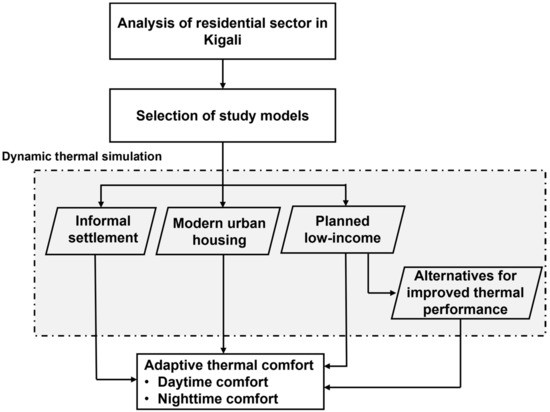
Figure 1.
Flowchart of the study process.
2.1. Study Models
The study models were selected based on the physical characteristics of each housing type in Kigali city, as described in the fifth Integrated Household Living Conditions Survey (EICV5) [8]. Kigali was selected as an ideal case study due to the ongoing expropriation of major informal settlements and its reputation as the fastest-growing city in Africa [6]. In addition, the city’s strict planning measures have reinforced urban spatial inequality, enabling this indoor environment evaluation to cover different socioeconomic groups. The characteristics of the three current neighborhoods in Kigali and typical housing from each category are displayed in Figure 2.
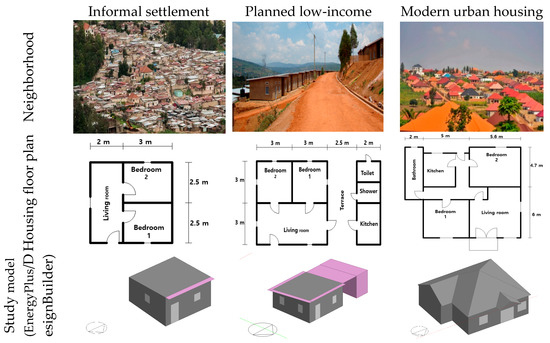
Figure 2.
Building types of the current urban fabric in Kigali and the selected study models.
A typical informal settlement is characterized by a floor area of about 24 m2, mud bricks covered with cement for walls, and metal iron sheets for roofing.
For the planned low-income housing study model, one house in the government-sponsored social housing project called Batsinda was selected. This project was among the earliest urban revitalization programs in Kigali, designed to provide 250 homes for low-income households from informal settlements [21]. The selected study model has a floor area of 36 m2 with two bedrooms, a living room, a kitchen, and separate toilet/shower (Figure 2); it is built of compressed stabilized earth blocks (CSEBs) for walls, metal iron sheets for roofing, cement for floors, and single-pane (3 mm) clear glass for windows.
The selected study model for modern urban housing has two bedrooms, a living room, a bathroom, and a kitchen, with a total floor area of 134 m2 (Figure 2). The housing is made of zinc-alloy-coated steel sheets for the roof, concrete blocks for the walls, tiles for the floor, and single-pane (6 mm) clear glass for the windows. Unlike the informal settlement and the planned low-income housing, the modern urban housing has a ceiling made of Nulite ceiling boards.
2.2. Simulation Tools and Conditions
Thermal performance was assessed through dynamic thermal simulations with EnergyPlus v9.4 software using the DesignBuilder program as the user interface. The accuracy of EnergyPlus/DesignBuilder in predicting the thermal performance of a naturally ventilated building is widely accepted [13]. Using Kigali’s typical meteorological year (TMY) weather data generated over 11 years (2005–2017), EnergyPlus predicted the hourly indoor operative temperature for each simulation model.
The thermal properties of the housing materials were obtained from the literature [22] and are displayed in Table 1. Only internal heat gains from the occupants were considered, as activities such as cooking are mostly done outside of the main building. The study considered four occupants per house (the average household size in Kigali), and internal heat gain was defined as 100 and 70 watts per person for seated and sleeping occupants, respectively. Furthermore, people’s habit of opening windows and doors for natural ventilation was taken into account by defining windows as being open from 6:30 a.m. to 6:30 p.m. and doors from 7 a.m. to 8 p.m. This schedule was adopted from a study in the region by Hashemi [16]. Air infiltration also plays a role in the thermal performance of a building; for new housing such as the planned low-income and modern urban housing studied here, the air infiltration was set to 5 ac/h [17], while for informal settlement the value was set to 7 ac/h, as cracks and gaps are expected in older and low-quality housing.

Table 1.
Thermal properties of the study models.
2.3. Performance Index
Various studies have been conducted to analyze the key factors in an occupant’s thermal comfort. A static model was developed by Fanger [23] based on experiments carried out under steady-state conditions in climate-controlled chambers. That model assumed that individual thermal preference is not influenced by psychological or regional factors. Later, de Dear and Brager [24,25] developed the adaptive comfort model based on a wide range of field studies conducted in real buildings across the world. Unlike the static model, the adaptive comfort model has led to a wider range of comfort zones as it takes into account that occupants actively take actions to achieve thermal comfort, such as opening or closing their windows, changing their clothing level, etc.
Since its development, the adaptive comfort model has been adopted by different international standards for built environments, such as ASHRAE (American Society of Heating, Refrigerating and Air Conditioning) Standard 55–2010 [26]. The concept of the adaptive comfort model has been widely applied in different studies across the world [27,28,29,30]. For thermal comfort investigations in exclusively naturally ventilated buildings and where occupants are free to adapt their clothing to achieve thermal comfort, ASHRAE recommends the use of the adaptive comfort model; hence, it was used in this study.
According to the ASHRAE adaptive comfort model, acceptable indoor temperature is not constant; rather, it varies depending on recent past outdoor temperatures. The acceptable temperature is calculated by: , where is the prevailing mean outdoor temperature which is calculated as the arithmetic average of the mean daily outdoor temperature of the seven days prior to the day in question. The prevailing mean outdoor temperature is calculated using the exponentially weighted running means, placing more weight on the most recent day, as follows: , where is the mean temperature of the previous day, for the day before the previous day, and so on [26].
The adaptive comfort model defines occupant thermal comfort based on operative temperature, which is derived from air temperature, mean radiant temperature, and air speed.
The ASHRAE adaptive comfort model determines the operative temperature range that is comfortable for 80% to 90% of occupants, as described in Figure 3a, and in this study, the adaptive comfort of 80% acceptability was applied. The upper and lower temperature limits are defined by extending the acceptable temperature by °C.
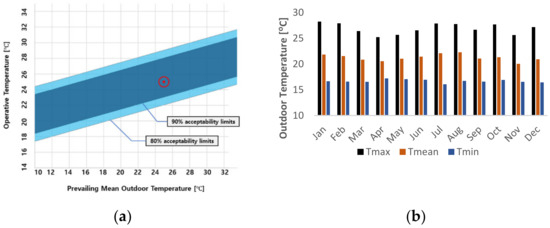
Figure 3.
(a) Adaptive comfort zone per the ASHRAE 55-2010 standard; (b) Kigali’s outdoor temperature variation through the year.
To evaluate the thermal performance of each housing model, the percentage of operative temperatures outside the adaptive comfort zone was calculated from the predicted hourly indoor operative temperature.
2.4. Analysis
In most studies, the thermal performance of buildings is evaluated for the summer and winter months considering seasonal temperature variation. However, in Kigali, the climate conditions are characterized by relatively constant temperatures throughout the year. As illustrated in Figure 3b, the seasonal temperature variation (approximately 3 °C) is less significant compared to diurnal temperature variations, which can reach up to 19 °C. Therefore, this study followed a daytime- and nighttime-based thermal comfort assessment rather than a seasonal evaluation.
Daytime and nighttime hours were defined based on the solar altitude angle calculated for each day of the year. The altitude angle θ, also known as the solar elevation angle, is defined as the angular height of the sun in the sky measured from the horizon, and is computed as: , where δ is the declination angle, ϕ is the latitude angle, and ω is the hour angle. The solar altitude angle varies throughout the day, and for this study, daytime hours were defined as the time when the solar altitude angle is greater than zero. For Kigali’s geographical location (latitude: −1.95, longitude: 30.05), daytime hours are defined as from 7:00 a.m. to 6:00 p.m.
Prior to our analysis, test simulations were carried out to evaluate the impact of internal walls on the overall thermal performance of the housing, as internal walls mainly influence the heat exchange between adjacent rooms rather than outdoor/indoor heat exchange. The results of the test simulations indicated a very slight difference between the simulation models with internal walls and the ones with a single thermal zone. For example, for the planned low-income housing, the percentage of operative temperatures falling outside the comfort range in the three thermal zones ranged from 63.8% to 66.2% with an average of 65.0%, while, for a single-zone model, 64.7% of the operative temperatures were outside the comfort range. Therefore, for the purpose of this study, no internal walls were included in any of the study models. A single-zone housing model for indoor thermal investigation has been widely used in other studies [18,31] to more easily manage the simulations and to enhance the results’ accuracy.
3. Results and Discussion
3.1. Thermal Comfort
For each study model, the predicted hourly operative temperature for the whole year and the defined adaptive comfort zone for Kigali city are displayed in Figure 4. The upper (blue) and lower (orange) lines in this figure indicate the upper and lower temperature limits for adaptive comfort model, respectively. Based on the ASHRAE adaptive comfort model used here, the calculated comfort conditions indicated that during daytime hours the operative temperatures between 20.4 and 27.5 °C met the 80% acceptability limit. For nighttime hours, the comfortable operative temperature range was 19.7 to 26.6 °C. Generally, for naturally ventilated buildings in regions with tropical climate conditions such as Kigali, much attention is given to indoor temperatures above the comfort zone during daytime hours as the outdoor temperatures are higher, while indoor temperatures below the comfort zone cause concern during nighttime hours. Therefore, for each of the analyzed housing types, the percentage of operative temperatures above and below the adaptive comfort zone is displayed in Figure 4 for daytime and nighttime hours, respectively.
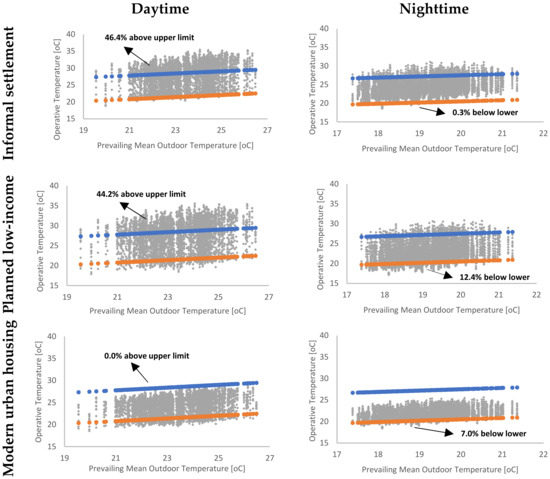
Figure 4.
Predicted hourly operative temperature and adaptive comfort zone.
According to the results, the operative temperature in the informal settlement fell outside the adaptive comfort zone for 47.4% of the annual daytime hours and 8.8% of the annual nighttime hours. As shown in Figure 4, the occupants in this housing are prone to heat discomfort as the indoor temperature tends to exceed the upper comfortable temperature limit, especially during daytime hours. To assess the accuracy of the simulation model in this study, the simulation results from this housing are compared with previous findings from a neighboring country with similar climatic conditions and building features as the informal settlement being analyzed. Hashemi et al. [32] analyzed the risk of overheating in rudimentary housing in Uganda. The authors reported that, for about 42.2% of the time, the temperature inside this type of housing was above the acceptable temperature and that, for around 65 days of the year, the indoor temperature exceeded the comfort range by up to 6 degrees. The heat discomfort predicted in this study is in line with previous investigations on the poor indoor environmental conditions of this type of housing in the region.
The thermal conditions in this type of housing are well explained by its envelope materials and construction. As mentioned previously, informal settlements are the result of gradual shifts in vernacular construction, with a major change in the roof construction from thatched roofs to metal iron sheets. Unlike thatched roofs in vernacular architecture, the iron sheets become overheated from solar radiation, and the absence of ceilings in these structures results in a drastic indoor temperature increase, especially during daytime hours.
In the case of the planned low-income housing, the operative temperature was outside the adaptive comfort zone for about 51.2% of the annual daytime hours and 19.5% of the annual nighttime hours. This overheating was mainly caused by the iron roof sheets with no ceilings, as was the case in the informal settlement. In addition to the roof overheating, the poor thermal performance of this housing was caused by its wall material. The results indicate that, unlike the informal settlement, the planned low-income housing was unable to maintain indoor temperatures above the lower comfort limit for 6.9% of the daytime hours and 12.4% of the nighttime hours. This suggests that the walls of this housing type, built of compressed stabilized earth blocks (CSEBs), cannot store much heat under high-temperature conditions and release it when the outdoor temperature drops. The poor thermal performance of CSEBs is explained by their manufacturing method which reduces their porosity and, consequently, increases their thermal conductivity [33]. To provide adequate indoor conditions with CSEBs, other building features should be well-designed, especially for locations with large daily temperature oscillations.
The operative temperature in the modern urban housing was outside the adaptive comfort zone for 11.5% of the annual daytime hours and 7.0% of the annual nighttime hours. Unlike the two other housing types, no operative temperature was above the upper comfort limit (Figure 4). The operative temperatures below the lower comfort limit were mainly caused by the low thermal storage capacity of the walls’ concrete blocks. The results indicate that the indoor space quickly lost its heat as the outdoor temperature dropped. Nonetheless, this housing performed better than the informal settlement and the planned low-income housing for both daytime and nighttime thermal comfort.
3.2. Thermal Performance Improvement
Of the three analyzed housing types, the planned low-income housing exhibited the poorest indoor thermal conditions. Approximately 77% of Kigali’s population currently lives in informal settlements, and the government’s plan is to relocate these dwellers to the planned urban neighborhood. It is therefore evident that the planned low-income housing could dominate Kigali’s residential building sector in the near future. For these reasons, we evaluated and maximized design parameters for the enhanced thermal performance of the planned low-income housing.
3.2.1. Design Parameters
The selection of simple, effective, and practical alternatives to improve the thermal performance of the planned low-income housing was carefully performed while considering the economic aspects of the target beneficiaries of this housing type. As mentioned previously, this type of housing is provided as in-kind compensation to the expropriated households who mostly belong to low- and middle-income population groups in Kigali and whose monthly income ranges between USD 220.63 and 320.00 [34]. A study [35] on housing affordability reported that housing investment costing less than 30% of the household income is affordable for the low-income urban households in Kigali. Therefore, through consultations with local construction experts, only design parameters that involve an additional construction cost less than 30% of the income of these population groups were analyzed.
Seven parameters that are known to influence heat exchange between outdoor and indoor spaces are considered here, namely: window size, ventilation rate, window shading, window material, wall thermal mass, wall cladding, and roof reflectivity. The values considered for each parameter are displayed in Table 2. These values were selected based on the design recommendations from both the Rwandan Building Code and local builders in order to ensure that only realistic values were considered.

Table 2.
The analyzed design features and their values.
Window size was defined as the window-to-wall ratio (WWR) and varied from 10% to 50% for each façade orientation. The ventilation rate referred to the percentage of the window area that is operable for natural ventilation, and four values from 25% to 100% were adopted. It should be pointed out that, while the Rwandan Building Code specifies the minimum window size for any habitable room (10% of the floor area), the code does not give any recommendations for maximum window size or suitable window operable area. The parameter of window shading was defined as an outer overhang of a length controlled by the projection factor, as shown in Figure 5. There are no guidelines regarding shading design in the local building code, and in this study a maximum of 0.6 projection factor was adopted to avoid too large of overhang which could require extra structural support or would significantly reduce the amount of daylight the building receives. To evaluate the effect of window materials, several different glazing materials were considered, namely: single-pane (3 mm) clear glass (SC-3 mm), single-pane (6 mm) clear glass (SC), single-pane (6 mm) bronze glass (SB), double-pane (6 mm) clear glass (DC), and double-pane (6 mm) bronze glass (DB). The thermal transmittance (U-value) and the solar heat gain coefficient (SHGC) of each glazing type are displayed in Table 2.
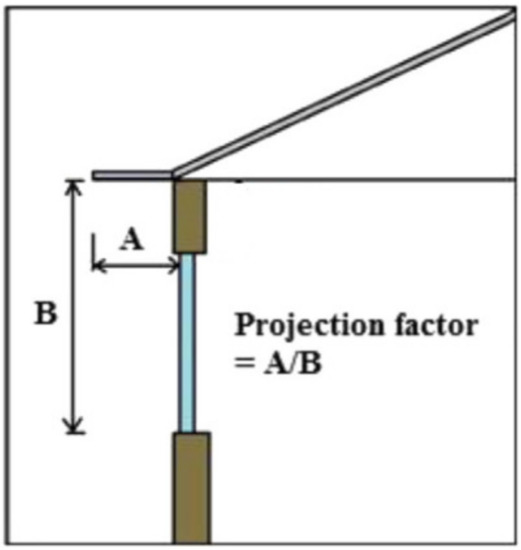
Figure 5.
Overhang projection factor.
Building thermal mass was considered by varying the wall thickness from 200 to 400 mm. The minimum value was defined based on the building code, while the 400 mm maximum was set based on local builders’ recommendations that a wall thicker than that would not be practical. The impact of wall cladding was evaluated by considering a clay layer ranging from 25 to 100 mm thick. The material for the wall cladding was selected based on locally available cladding material, and its thermal and physical properties were 0.21 W/m2.K for thermal conductivity, 2576.94 J/kg.K for specific heat, and 1933 Kg/m3 for density [36].
The results from the previous step indicated that the roof greatly contributes to high indoor temperatures in this housing. Among different strategies to improve roof construction, reducing solar absorptance by applying low-solar-absorption paint was deemed to be the simplest and most affordable solution for the low-income housing. A reflective roof, defined as a roof painted to reduce solar heat gain, was applied with a solar absorptance ranging from 0.5 to 0.2.
3.2.2. Thermal Improvement by Different Design Parameters
In order to evaluate the impacts of the analyzed design parameters, each parameter was modified one-by-one, and the results were computed against the base model representing the planned low-income housing as currently designed. The purpose was to highlight the most influential parameters and to apply the defined order during multiple parameter optimization.
Similar to the analysis in the previous subsection, thermal performance improvement was assessed by calculating the percentage of operative temperatures outside the adaptive comfort zone during daytime and nighttime hours. Results are displayed in a four-quadrant diagram (Figure 6) with the X- and Y-axis indicating the percentage of operative temperatures outside comfort zone for the annual nighttime and daytime hours, respectively. In this diagram, the origin represents the nighttime and daytime thermal performance of the base model (the planned low-income housing as currently designed). The analyzed design parameters are categorized as improved daytime and nighttime thermal comfort (Quadrant III), improved daytime and reduced nighttime thermal comfort (Quadrant IV), and improved daytime thermal comfort with little impact on nighttime thermal (along the Y-axis). For easy reference, the percentages of predicted operative temperatures outside the adaptive comfort zone for each window size and wall cladding are displayed in Table 3 and Table 4.
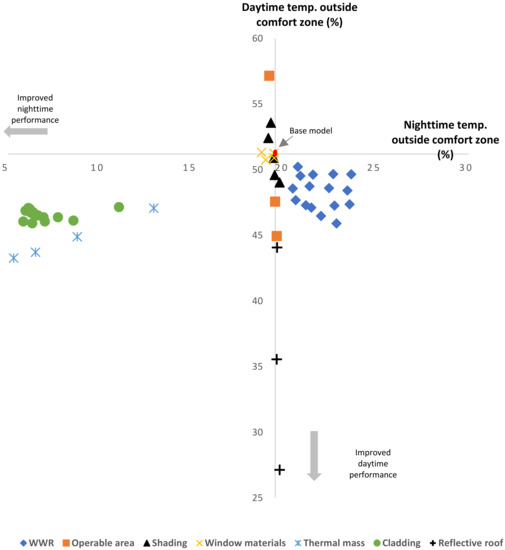
Figure 6.
Effect of each parameter on the percentage of operative temperatures outside the adaptive comfort zone during daytime and nighttime hours.

Table 3.
Effects of window size on thermal performance of the base model.

Table 4.
Effects of wall cladding on thermal performance of the base model.
Results indicate that increasing the size of the window slightly worsened the model’s nighttime thermal performance but improved the thermal conditions during daytime hours, especially for east-oriented windows. This is because, for this type of housing, 72.4% of the operative temperatures outside the adaptive comfort zone fell above the upper acceptable limits (heat discomfort); hence, increasing the window size provided more ventilation and reduced indoor temperature. On the other hand, larger windows resulted in more heat loss when the outdoor temperature drops, such as during nighttime hours. The impact of the other three window parameters on nighttime comfort was marginal, as can be seen in Figure 5. The degree to which a window can be opened (its operable area) influenced the indoor thermal conditions during the daytime. The percentage of operative temperatures outside the adaptive comfort zone is reduced by 12.3% if the window can be fully opened (100% window operable area). In addition, increasing the overhang projection factor from 0.00 to 0.6 reduced the number of operative temperatures outside the adaptive comfort zone by 8.4% during the daytime hours. Among all the analyzed parameters, window materials showed the least influence on this housing type’s thermal performance. Changing the window glazing type from single- to double-pane reduced the number of operative temperatures outside the adaptive comfort zone by only 1.0%. This could be because of the small window size in this housing model.
Increasing the wall thermal mass improved both the daytime and nighttime indoor thermal conditions. By changing the wall thickness from 200 to 400 mm, the percentage of operative temperatures outside the adaptive comfort zone was reduced by 15.6% and 72.8% for the daytime and nighttime hours, respectively. Similarly, adding a 25 mm cladding layer on the base model improved the indoor thermal conditions by 8% and 43.5% during the daytime and nighttime hours, respectively. However, the results also indicate that increasing the cladding thickness does not necessarily result in greater thermal improvement, especially for walls with higher thermal mass. As displayed in Table 4, for a wall thickness greater than 200 mm, wall cladding slightly decreased the thermal performance during daytime hours.
Applying roof paint with low solar absorptance, described here as a reflective roof, significantly enhanced the daytime indoor thermal conditions. By reducing the solar absorptance from 0.7 to 0.2 (white-painted roof), the number of operative temperatures outside the adaptive comfort zone were reduced by 58.0% during the daytime hours. As expected, this parameter did not influence indoor thermal conditions during nighttime, as there are no direct solar heat gains during those hours.
3.2.3. Multiple Parameter Optimization
Based on the results from the previous subsection, it is clear that optimizing one parameter can only improve indoor thermal conditions to a certain extent. We therefore carried out multiple parameter optimization to maximize the thermal performance improvement of the base model. The optimization was conducted beginning with the most influential parameter for daytime thermal performance, because the number of operative temperatures outside the adaptive comfort zone was about 2.6 times higher during the daytime than during the nighttime hours.
Once the optimal value of a given parameter was defined, this value was applied in the simulation model for analysis of the next subsequent parameter until the optimal value for the final analyzed parameter was determined. The optimization was done in the order of reflective roof, wall thermal mass, wall cladding, window size, window operable area, window shading, and window material. The results of the optimization are displayed in Figure 7 and Figure 8 for daytime and nighttime thermal comfort, respectively. As indicated in Table 5, the design parameters’ values for the fully optimized model are 0.2 for roof reflectance, 400 mm for wall thickness, 20% window-to-wall ratio on the east-oriented façade and 10% window-to-wall ratio on the three other façade orientations, 50% window operable area, 0.3 projection factor for overhang, and double-pane (6 mm) clear glass for window material.
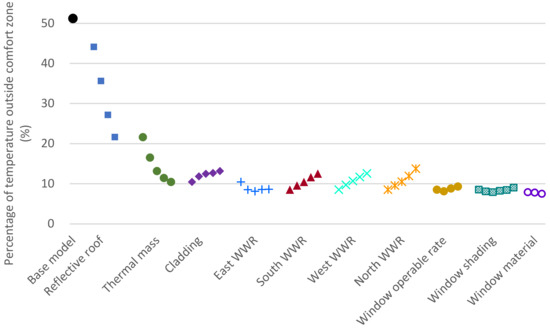
Figure 7.
Multiple parameter optimization and the reduction in the percentage of operative temperatures outside the adaptive comfort zone during daytime hours.
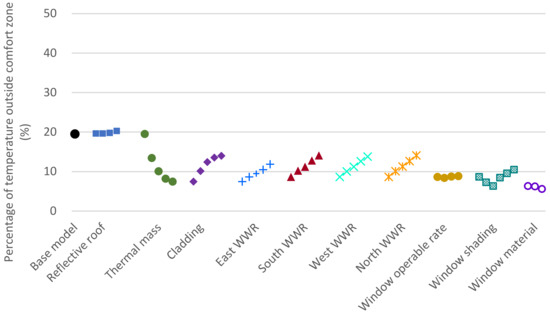
Figure 8.
Multiple parameter optimization and the reduction in the percentage of operative temperatures outside the adaptive comfort zone during nighttime hours.

Table 5.
Optimal value for each of the analyzed design parameters.
For daytime thermal comfort, the percentage of operative temperatures outside the adaptive comfort zone changed from 51.2% in the base model to 7.7% in the fully optimized model (Figure 7). In regard to nighttime comfort, the operative temperature was outside the adaptive comfort zone for 5.5% of the time in the optimized model, down from 19.5% in the base model (Figure 8). In brief, the fully optimized model improved indoor thermal conditions by about 85.5% and 71.8% during daytime and nighttime hours, respectively.
3.3. Further Analysis
Results from the previous section indicate the thermal performance improvement of the optimized model based on the number of operative temperatures inside the adaptive comfort range. Nonetheless, it is important to assess whether the stability of the indoor thermal conditions was improved as well.
Designing a naturally ventilated building is often perceived as a challenging task because it aims to provide indoor temperature stability despite diurnal outdoor temperature fluctuations. Here, the thermal performance of the optimized model on a typical day with a large daily oscillation in outdoor air temperature (14 °C–33 °C) is analyzed and compared with the base model (the planned low-income housing as currently designed).
As illustrated in Figure 9a, the optimized model improved the indoor thermal conditions by reducing the indoor peak temperature during daytime hours (gray-shaded area) and providing warmer indoor conditions when the nocturnal temperatures fell noticeably. The high thermal mass of the optimized model helped in storing heat, which was released when the outdoor temperatures dropped, while a reflective roof mitigated the daytime overheating issue of the base model.

Figure 9.
(a) The outdoor temperature on a typical day with large diurnal variation and the indoor temperature in the base model and optimized model; (b) The annual number of hours when the operative temperature was outside the adaptive comfort zone by temperature difference from comfort limits.
A similar indoor thermal stability analysis was done by calculating the annual number of hours when the indoor operative temperature is above or below the adaptive comfort limit (ΔT) by 1 °C, 2 °C, 3 °C, and more than 3 °C (ΔT > 3 °C). The results in Figure 9b indicate that for optimized model, among all the operative temperatures outside the adaptive comfort zone, 89.9 and 94.2% of them are over the upper comfort limit or below the lower comfort limit by less than 1 °C during the daytime and nighttime hours, respectively. In addition, no indoor operative temperature was above or below the adaptive comfort zone by 3 °C or more during either daytime or nighttime hours. This confirmed that thermal performance improvement was achieved by integrating all the relevant design parameters in the analyzed planned low-income housing.
4. Conclusions
The urban fabric of most developing countries is undergoing major upgrades by clearing out informal settlements and promoting planned urban neighborhoods. This study challenges the primary urban upgrading goal of improving living conditions of urban habitants by assessing and comparing the thermal performance of the existing informal settlements and the currently promoted urban housing types, namely, the planned low-income housing and the modern urban housing in Kigali, Rwanda. The focus of this study was two-fold. First, the study assessed for the first time the thermal performance of the three major housing types in Kigali and analyzed whether the current housing transition caused by urban re-development is leading toward improved indoor thermal conditions. Second, design alternatives to improve the thermal performance of the planned low-income housing were analyzed and maximized.
With respect to the first focus, results indicate that—although the modern urban housing has improved thermal performance compared to the two other housing types—the indoor thermal conditions in the planned low-income housing are no better than in the informal settlements from which households are to be relocated. During daytime hours, the operative temperature was outside the ASHRAE adaptive comfort zone for 11.5% of the time in the modern urban housing studied here, 47.4% of the time in the informal settlement, and 51.2% of the time in the planned low-income housing. For nighttime hours, the operative temperature was outside the adaptive comfort zone for 7.0% of the time in the modern urban housing, 8.8% in the informal settlement, and 19.5% in the planned low-income housing. Informal settlement dwellers expect resettlement projects to bring significant life improvements that outweigh the adverse impacts associated with induced displacement. Failure to improve indoor conditions in the planned low-income housing can contribute to low acceptance of, and social opposition to, urban re-development projects which are among the biggest challenges faced by authorities in cities undergoing major urban renewal.
Concerning the second focus, this study found that thermal conditions in the planned low-income housing in Kigali can be improved by the proper design of seven parameters related to the building envelope. The optimized housing model’s indoor thermal conditions improved by 85.5% in the daytime hours and 71.2% in the nighttime hours. In addition, indoor thermal stability in the optimized model was improved by reducing the indoor peak temperature during daytime hours and providing warmer indoor temperatures during nighttime hours. With the optimized model, no operative temperature was above or below the adaptive comfort zone by 3 °C or more during either daytime or nighttime hours. These findings extend the existing knowledge on how transitions in housing design affect housing performance, focusing on urban re-development in non-industrialized countries. The study provides a practical procedure for decision makers in urban upgrading programs on how to develop projects with wholistic solutions to enhance the living conditions of urban habitants. This can reduce social resistance from targeted communities and contribute to the success of urban upgrading programs.
5. Limitations and Future Works
The study was primarily based on thermal performance from dynamic simulations. Although the results were in line with previous findings in the region, it is important to analyzed housing types through on-site thermal performance assessment. For a country like Rwanda, where designing for thermal comfort is nearly nonexistent, this study is a step in the right direction towards modernized building codes that take into consideration occupant comfort. In addition, the optimization in this study was limited to the thermal performance of the design parameters. Future work will be extended to include cost analysis and residents’ preference of the proposed design alternatives, and the investigation will be further enhanced by applying advanced multivariate optimization methods that integrate the thermal performance, cost implications, and willingness to adopt the measures for the improvement of indoor thermal conditions. Furthermore, considering that the consequences of global warming are expected to affect the low-income populations in the sub-Saharan region of Africa the worst, further investigation should evaluate the resilience of the proposed measures to various future climate scenarios.
Author Contributions
A.I. and K.H.K. performed the conceptualization of this study. K.L. advised throughout the research process. A.I. wrote the first draft of the manuscript and K.H.K. reviewed and edited the work. All authors have read and agreed to the published version of the manuscript.
Funding
This work was supported by the 2022 Research Fund of University of Ulsan.
Conflicts of Interest
The authors declare no conflict of interest.
References
- Van Noorloos, F.; Kloosterboer, M. Africa’s new cities: The contested future of urbanisation. Urban Stud. 2018, 55, 1223–1241. [Google Scholar] [CrossRef] [PubMed]
- Patel, S.; Sliuzas, R.; Mathur, N. The risk of impoverishment in urban development-induced displacement and resettlement in Ahmedabad. Environ. Urban. 2015, 27, 231–256. [Google Scholar] [CrossRef]
- Benken, E.E. Nowhere to Go: Informal Settlement Eradication in Kigali, Rwanda. Senior Honors Thesis, College of Arts and Sciences, University of Louisville, Louisville, KY, USA, 2017. [Google Scholar] [CrossRef]
- Lueker, J.J. Exploring Mechanisms for Improved Air Quality in Mumbai Resettlement Dwellings: Evidence From Fieldwork And Simulation. Ph.D. Thesis, Massachusetts Institute of Technology, Cambridge, MA, USA, 2019. [Google Scholar]
- Tawayha, F.A.; Braganca, L.; Mateus, R. Contribution of the vernacular architecture to the sustainability: A comparative study between the contemporary areas and the old quarter of a Mediterranean city. Sustainability 2019, 11, 896. [Google Scholar] [CrossRef]
- Nikuze, A.; Flacke, J.; Sliuzas, R.; van Maarseveen, M. Urban induced-displacement of informal settlement dwellers: A comparison of affected households’ and planning officials’ preferences for resettlement site attributes in Kigali, Rwanda. Habitat Int. 2022, 119, 102489. [Google Scholar] [CrossRef]
- Rwanda Ministry of Infrastructure (MININFRA). National Informal Settlement Upgrading Strategy. 2016. Available online: https://www.mininfra.gov.rw/digital-transformation-1 (accessed on 24 April 2021).
- NISR. National Institute of Statistics of Rwanda: Rwanda Integrated Household Living Conditions Survey 5 (EICV5). 2018. Available online: https://www.statistics.gov.rw/datasource/integrated-household-living-conditions-survey-5-eicv-5 (accessed on 15 May 2021).
- Ramakrishnan, S.; Wang, X.; Sanjayan, J.; Wilson, J. Thermal performance of buildings integrated with phase change materials to reduce heat stress risks during extreme heatwave events. Appl. Energy 2017, 194, 410–421. [Google Scholar] [CrossRef]
- Rodrigues, L.; White, J.; Gillott, M.; Braham, E.; Ishaque, A. Theoretical and experimental thermal performance assessment of an innovative external wall insulation system for social housing retrofit. Energy Build. 2018, 162, 77–90. [Google Scholar] [CrossRef]
- Zhang, X.; Lv, J.; Dawuda, M.M.; Xie, J.; Yu, J.; Gan, Y.; Zhang, J.; Tang, Z.; Li, J. Innovative passive heat-storage walls improve thermal performance and energy efficiency in Chinese solar greenhouses for non-arable lands. Sol. Energy 2019, 190, 561–575. [Google Scholar] [CrossRef]
- Bauman, F.; Raftery, P.; Kim, J.; Kaam, S.; Schiavon, S.; Zhang, H.; Arens, E.; Brown, K.; Peffer, T.; Blumstein, C.; et al. Changing the Rules: Innovative Low-Energy Occupant-Responsive HVAC Controls and Systems. 2017. Available online: https://escholarship.org/ (accessed on 23 December 2022).
- Rijal, H.B.; Yoshida, K.; Humphreys, M.A.; Nicol, J.F. Development of an adaptive thermal comfort model for energy-saving building design in Japan. Archit. Sci. Rev. 2021, 64, 109–122. [Google Scholar] [CrossRef]
- Ryu, J.; Kim, J.; Hong, W.; de Dear, R. Defining the thermal sensitivity (Griffiths constant) of building occupants in the Korean residential context. Energy Build. 2020, 208, 109648. [Google Scholar] [CrossRef]
- Wu, Z.; Li, N.; Wargocki, P.; Peng, J.; Li, J.; Cui, H. Adaptive thermal comfort in naturally ventilated dormitory buildings in Changsha, China. Energy Build. 2019, 186, 56–70. [Google Scholar] [CrossRef]
- Hashemi, A. Climate resilient low-income tropical housing. Energies 2016, 9, 468. [Google Scholar] [CrossRef]
- Eyre, M.; Hashemi, A.; Cruickshank, H.; Jordan, M. Transition in housing design and thermal comfort in rural Tanzania. In Proceedings of the 5th International Conference on Zero Energy Mass Customised Housing-ZEMCH 2016, Kuala Lumpur, Malaysia, 20 December 2016; pp. 79–98. [Google Scholar]
- Kalua, A. Envelope thermal design optimization for urban residential buildings in Malawi. Buildings 2016, 6, 13. [Google Scholar] [CrossRef]
- Pathirana, S.; Rodrigo, A.; Halwatura, R. Effect of building shape, orientation, window to wall ratios and zones on energy efficiency and thermal comfort of naturally ventilated houses in tropical climate. Int. J. Energy Environ. Eng. 2019, 10, 107–120. [Google Scholar] [CrossRef]
- Kariuki, R.N.; Mugwima, B.N.; Kaluli, W. Determination of the Thermo-physical Properties of Walling Materials for Thermal Comfort in the Sub-Tropic Highland Climate, Kenya. In Proceedings of the Sustainable Research and Innovation Conference, Nairobi, Kenya, 6 May 2015; pp. 242–246. [Google Scholar]
- The City of Kigali. Developing Batsinda Site. Available online: https://kigalicity.gov.rw/index.php?id=94&L=0 (accessed on 18 May 2021).
- UN-HABIT. Sustainable Building Design for Tropical Climates. Principles and Applications for Eastern Africa. Available online: https://unhabitat.org/sites/default/files/download-manager-files/Sustainable%20Building%20Design%20for%20Tropical%20Climates_1.pdf (accessed on 20 May 2020).
- Fanger, P.O. How to Apply Models Predicting Thermal Sensation and Discomfort in Practice in Thermal Comfort: Past, Present and Future; Oseland, N.A., Humphreys, M.A., Eds.; BRE Report; HIS BRE Press: Berkshire, UK, 1994. [Google Scholar]
- De Dear, R.; Brager, G.S. Developing an adaptive model of thermal comfort and preference. ASHRAE Trans. 1998, 104, 145–167. [Google Scholar]
- De Dear, R.J.; Brager, G.S. Thermal comfort in naturally ventilated buildings: Revisions to ASHRAE Standard 55. Energy Build. 2002, 34, 549–561. [Google Scholar] [CrossRef]
- De Dear, R. Recent enhancements to the adaptive comfort standard in ASHRAE 55-2010. In Proceedings of the 45th annual conference of the Architectural Science Association, Sydney, Australia, 31 May 2011; pp. 16–19. [Google Scholar]
- Indraganti, M. Behavioural adaptation and the use of environmental controls in summer for thermal comfort in apartments in India. Energy Build. 2010, 42, 1019–1025. [Google Scholar] [CrossRef]
- Zhong, K.; Fu, H.; Kang, Y.; Peng, X. Indoor thermal conditions and the potential of energy conservation of naturally ventilated rooms in summer, China. Energy Build. 2012, 55, 183–188. [Google Scholar] [CrossRef]
- Soebarto, V.; Bennetts, H. Thermal comfort and occupant responses during summer in a low to middle income housing development in South Australia. Build. Environ. 2014, 75, 19–29. [Google Scholar] [CrossRef]
- Rincón, L.; Carrobé, A.; Martorell, I.; Medrano, M. Improving thermal comfort of earthen dwellings in sub-Saharan Africa with passive design. J. Build. Eng. 2019, 24, 100732. [Google Scholar] [CrossRef]
- Dong, X.; Soebarto, V.; Griffith, M. Achieving thermal comfort in naturally ventilated rammed earth houses. Build. Environ. 2014, 82, 588–598. [Google Scholar] [CrossRef]
- Hashemi, A.; Cruickshank, H.; Cheshmehzangi, A. Improving Thermal Comfort in Low-Income Tropical Housing: The case of Uganda. In Proceedings of the ZEMCH 2015 International Conference (ZEMCH Network), Bari-Lecce, Italy, 21 September 2015; pp. 613–622. [Google Scholar]
- Mansour, M.B.; Jelidi, A.; Cherif, A.S.; Jabrallah, S.B. Optimizing thermal and mechanical performance of compressed earth blocks (CEB). Constr. Build. Mater. 2016, 104, 44–51. [Google Scholar] [CrossRef]
- Uwayezu, E.; De Vries, W.T. Indicators for measuring spatial justice and land tenure security for poor and low income urban dwellers. Land 2018, 7, 84. [Google Scholar] [CrossRef]
- Uwayezu, E.; Vries, W.T.D. Access to Affordable Houses for the Low-Income Urban Dwellers in Kigali: Analysis Based on Sale Prices. Land 2020, 9, 85. [Google Scholar] [CrossRef]
- Oluyimika, O.M.; Mijinyawa Yahaya, F.S. An investigation into the thermal properties of termite mound clay applicable to grain silo construction. Int. J. Mater. Sci. Appl. 2015, 4, 66–271. [Google Scholar]
Disclaimer/Publisher’s Note: The statements, opinions and data contained in all publications are solely those of the individual author(s) and contributor(s) and not of MDPI and/or the editor(s). MDPI and/or the editor(s) disclaim responsibility for any injury to people or property resulting from any ideas, methods, instructions or products referred to in the content. |
© 2023 by the authors. Licensee MDPI, Basel, Switzerland. This article is an open access article distributed under the terms and conditions of the Creative Commons Attribution (CC BY) license (https://creativecommons.org/licenses/by/4.0/).